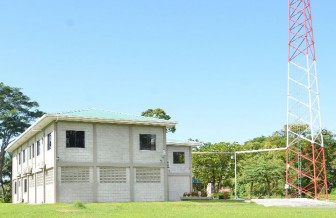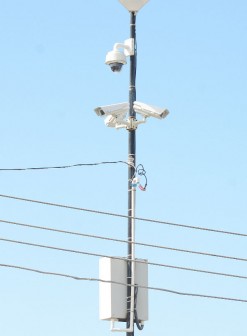All of the much talked about Close Circuit Television (CCTV) cameras have been installed and a special team is analyzing and storing the footage obtained on a regular basis.
Home Affairs Minister Clement Rohee while being unable to provide the figure for the cost of the installation of the cameras said recently that the images captured came in handy in several police investigations.

More than 100 cameras have been installed near traffic lights around Georgetown. Government had repeatedly said that because of their prime locations, the cameras could assist in not only apprehending or identifying traffic offenders but also in the crime fight.
Government had promised the installation of the cameras at the height of the crime spree back in 2005. It was felt that the cameras could go a far way in solving some of the crimes, which were being committed in the city and other places. Armed robberies had soared particularly towards the end of that year and even though there was a heightened police presence in the city, bandits continued to plunder businesses, rob citizens and escape.
In August 2005, government had said it would purchase the cameras for the police force and the then home affairs minister, Gail Teixeira, had told Stabroek News that by the end of that year the cameras would have been in place.
Former president Bharrat Jagdeo had announced the allocation of $50 million to purchase, among other things, the surveillance cameras.
The installation process began last August but several months later Head of the Presidential Secretariat, Dr Roger Luncheon, had said that while around 130 had been installed, the unavailability of reliable back-up power from the Guyana Power and Light could be a problem.
Rohee in a brief interview with Stabroek News recently said that the installation of the cameras was completed. Last November, he had told the media that those that were already installed were working and being monitored, days after the now Natural Resources Minister Robert Persaud had alleged that persons were caught on the camera destroying one of the party’s billboards.
According to the minister, the cameras undergo “upgrades from time to time and they have been capturing a lot of images”. He did not elaborate on the kinds of images or the relevance of the images to police work but insisted that they were all working.
He explained that the footage is going to the Headquarters of the Central Intelligence Unit (CIU) located behind Castellani House. There is “a team there” that is constantly monitoring the footage and whatever action needs to be taken is taken especially if “it’s a traffic accident and someone wants a further investigation to be made or whatever the case might be”.

When asked if the footage has been useful thus far, he responded “I don’t think that any has so far been used as evidence in court but they have been used as far as I am aware to investigate different offences”. He did not explain what those “different offences” were, but insisted that they were functioning.
In April, Luncheon had said that the completion of the installing of the cameras would pave the way for CIU to be linked to key departments of the Guyana Police Force.
“Our plan is to have that information now from the primary monitoring site to seamlessly go to other law enforcement bodies, [such as the] Commissioner’s office, Brickdam [Police Station], Kitty [Police Station] and other places,” he said, adding that the idea was to have live feed rather than written or telephone information. It is unclear when this aspect of the plan would be worked on.
The installation of the cameras has been met with opposing views from those in the security world.
Retired Brigadier and APNU leader David Granger had expressed the view that the money would have been better spent improving the force. He said it was unclear what the true purpose of the cameras is. “Nobody knows exactly why they are being installed. Are they to control traffic or prevent crimes? Are they to control or prevent riots or are they to deter crime or detect crime?” he asked.
Granger had drawn Stabroek News’ attention to the fact that the greatest volumes of crime were being committed away from the city. He stated that there are some who regard the project as a potential invasion of privacy depending on who would monitor that footage. “It might turn out to be building a surveillance society,” he commented.
According to Granger, CCTV cameras would be of little value and would have a very limited impact on the crime situation if that is the intended purpose adding that the maintenance cost would be very high.
However, Chief Executive Officer of GEB Security Services Maurice Amres and former police Commissioner Winston Felix both felt that this was a move in the right direction.
Amres said the project is a good idea not only because it will reduce the number of police ranks on the streets, but also because it will act as a deterrent to crime. He said that this piece of security equipment has worked well in places such as London and Miami while describing CCTV as a sophisticated version of a video camera.
Felix, now an APNU MP, had stated that the introduction of CCTV cameras was long overdue and if used correctly could be of great benefit. He said that with this move the force is now up to par with others. He said this was long overdue but noted that the cameras have to be in crime prone areas, for example near markets and around banks.
He said the cameras could be used for both traffic and crime-related purposes. “My first shot would be [to use them as] a crime and drugs prevention/detection device,” he commented.




